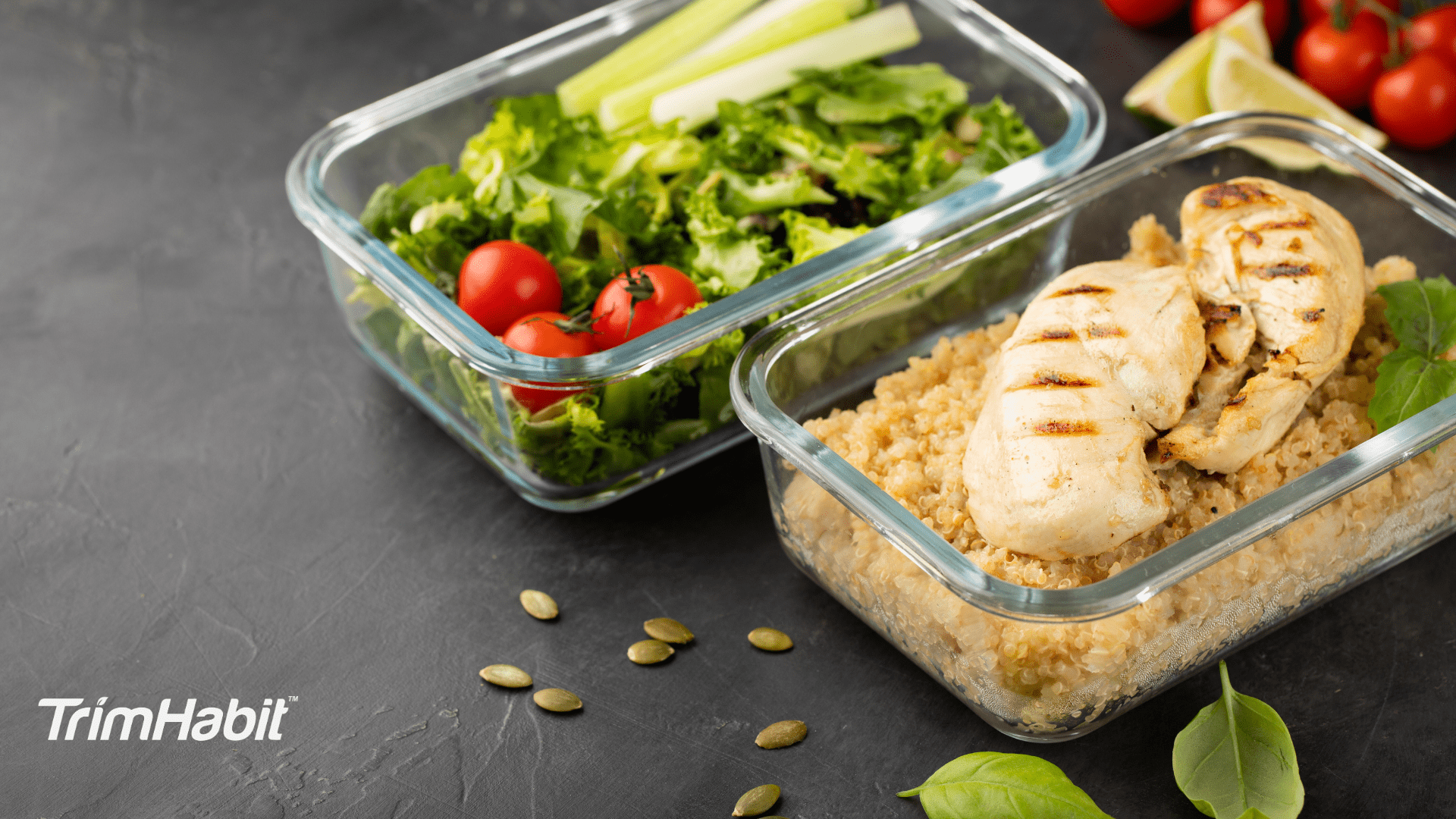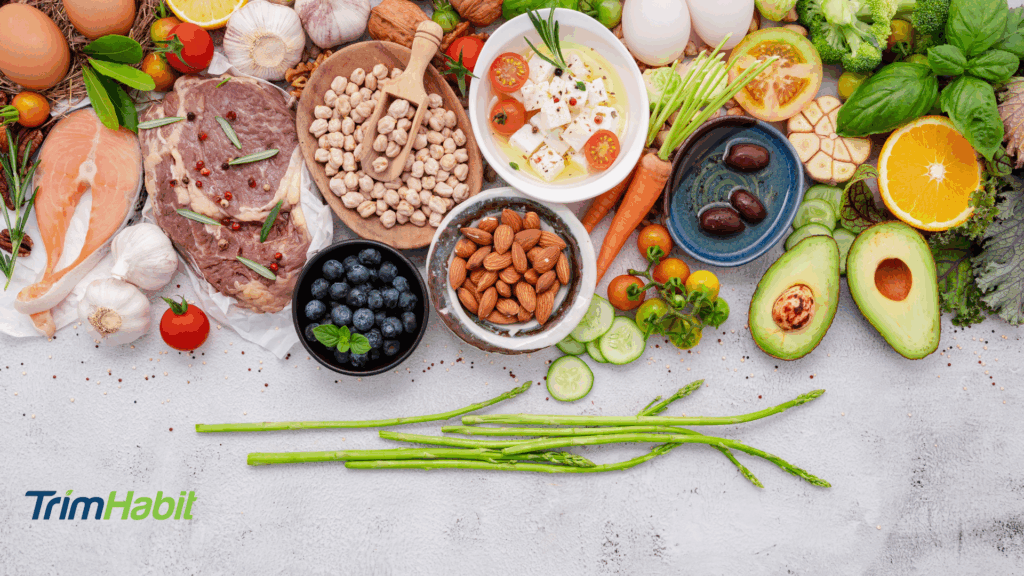Meal prep for semaglutide and healthy eating offers structure and control during a time when dietary consistency matters most. When prescribed semaglutide, individuals often find that planning meals in advance can help reduce calorie intake, control portions, and make food decisions easier throughout the week. A well-structured meal plan helps ensure you’re consuming nutrient-rich foods that support your weight loss progress and health.
Semaglutide is a medication designed to assist people with weight management, blood sugar regulation, and appetite control1. However, the drug works most effectively when paired with consistent, healthy dietary choices. That’s where meal prep plays an essential role. Preparing food ahead of time promotes sustainable eating habits, supports healthy digestive function, and minimizes the temptation of impulsive choices such as sugary foods or fried foods.
Understanding The Role Of Nutrition When Taking Semaglutide
Taking semaglutide reduces hunger and slows stomach emptying. These effects mean the body becomes more sensitive to what it consumes. A diet high in nutrient-dense foods becomes more than just a health recommendation. It becomes necessary to support energy, digestion, and metabolic function.
Meals should include lean proteins, healthy fats, whole grains, and non-starchy vegetables. This combination helps regulate blood sugar levels and promote satiety. Foods that are high in refined carbohydrates or saturated fat may lead to blood sugar spikes and stomach discomfort, both of which can impede weight loss or cause unnecessary side effects.
The objective isn’t just to lose weight but to create a lasting change in eating patterns that can be sustained long-term. Nutrient-dense meals give the body the fuel it needs, even while consuming fewer calories.
Key Elements Of A Balanced Diet
A balanced diet is built from food categories that nourish and support bodily functions while promoting a healthy body weight. Focusing on quality, whole foods is a starting point.
1. Lean Proteins and Protein Intake
Protein supports muscle mass and satiety. With semaglutide slowing digestion and decreasing appetite, adequate protein intake is crucial to maintain muscle mass while body weight decreases. Options like chicken breast, turkey, fish, tofu, lentils, and plain Greek yogurt work well in any meal prep rotation. Greek yogurt, in particular, can be a helpful addition to breakfast or snacks due to its high protein content and versatility.
2. Whole Grains and Fiber-Rich Foods
Whole grains like cooked wheat berries and brown rice provide slow-digesting carbohydrates that help stabilize blood sugar. Compared to refined carbohydrates, whole grains lead to better blood sugar control and less fatigue. They also support digestive health by providing essential dietary fiber.
3. Non Starchy Vegetables and Leafy Greens
Non-starchy vegetables such as green beans, zucchini, peppers, broccoli, and leafy greens add volume to meals without significantly increasing calorie intake. These are packed with micronutrients and water, making them ideal for satiety. Leafy greens also provide antioxidants that contribute to long-term health.
4. Healthy Fats
Healthy fats, including olive oil, avocado, nuts, seeds, and fatty fish like salmon, improve meal satisfaction and support hormone function. Despite being calorie-dense, when eaten in moderation, they do not promote weight gain but rather help regulate hunger.
Avoiding Common Pitfalls
Some foods can work against the benefits of semaglutide. Understanding which foods to avoid is just as important as knowing which foods to eat.
Sugary Foods and High Fat Foods
Candy, soda, pastries, and sweetened beverages are high in added sugars and provide little nutritional value. These options can interfere with blood sugar control and increase cravings later in the day. Similarly, high-fat foods from processed or fast food sources often contain unhealthy fats that can cause bloating and stomach pain and hinder fat loss.
Processed Foods and Refined Carbohydrates
Packaged snacks, frozen meals, white bread, and sweetened breakfast cereals may contain additives, sodium, and hidden sugars. These ingredients can cause energy crashes and increase the chance of weight gain, especially when used frequently.
Carbonated Beverages and Energy Drinks
Drinks that are carbonated or heavily caffeinated can irritate the stomach, especially in those taking semaglutide. They can also cause water retention, jitteriness, and disturb digestion. It’s helpful to monitor caffeine intake and favor water, herbal teas, or infused waters with lemon and mint.
Spicy Foods and Fatty Foods
Meals that are extremely spicy or overly greasy can upset the stomach while using semaglutide. While not everyone reacts the same, spicy foods should be introduced cautiously and not in combination with large portions of fatty foods.
Creating A Semaglutide Diet Plan
Creating a personalized semaglutide diet plan starts with consistency, awareness, and variety. Planning meals ahead allows for thoughtful combinations that offer nutrition, taste, and satisfaction.
Each of the meal sample ideas below supports balanced nutrient intake, minimizes the use of processed ingredients, and helps maintain appropriate portion sizes.
Breakfast Ideas
Scrambled eggs with sautéed spinach and a slice of whole grain toast
Greek yogurt with chia seeds, berries, and a sprinkle of chopped almonds
Smoothie made with protein powder, frozen berries, leafy greens, and almond milk
Lunch Ideas
Grilled chicken over a mixed green salad with olive oil and vinegar
Brown rice bowl with roasted vegetables, chickpeas, and tahini drizzle
Turkey and avocado wrap using a whole grain tortilla and a side of green beans
Dinner Ideas
Baked salmon with cooked wheat berries and steamed broccoli
Stir-fry with lean meats, non-starchy vegetables, and a tamari glaze
Lentil and vegetable stew with a slice of toasted whole-grain bread
Snacks
Baby carrots with hummus
Plain Greek yogurt with cinnamon and sliced strawberries
Boiled eggs with a few olives or cucumber slices
Practicing Smart Meal Prep Habits
To make meal prep sustainable, start with a few meals at a time. Use containers to store individual portions. Cook large batches of lean proteins and whole grains, then rotate different vegetables and sauces to add variety. This keeps the process efficient without becoming monotonous.
Label containers with dates to stay organized and reduce waste. Use see-through containers to make meals visually accessible in the fridge. Frozen items such as lean meats, homemade soups, or vegetable stews can be prepared in advance and defrosted as needed.
Meal prep encourages routine and less dependence on convenience items. Having a ready-to-eat option prevents impulsive choices and reduces reliance on fast food or delivery.
Key Considerations During A Weight Loss Journey
The process of losing excess weight requires more than simply reducing portion sizes. The quality of calories matters as much as the quantity. A reduced calorie diet must still contain essential nutrients to preserve lean muscle mass, support energy, and protect metabolic function.
The combination of semaglutide with a nutrient-dense diet leads to steady and effective weight loss over time. However, tracking weight loss alone is not always the best marker of progress. Pay attention to changes in clothing fit, energy, sleep quality, and digestion. These indicators can often show improvement before dramatic changes appear on the scale.
To support lean muscle mass and metabolic health during the weight management journey, resistance training or strength-building exercises are highly recommended alongside regular movement such as walking or yoga. These activities complement healthy foods and promote long-term results.
Staying Consistent With Healthy Eating
A healthy diet should not feel restrictive. Including a variety of flavors, textures, and cuisines makes eating enjoyable and reduces the chance of falling into patterns that involve processed foods or boredom.
The foundation of healthy eating begins with foods high in nutrients and lower in added sugars or unhealthy fats. Eating foods that are fresh, colorful, and close to their natural state is one of the simplest ways to eat well. Fruits and vegetables, especially when seasonal and ripe, can be a flavorful way to enhance meals.
To maintain a steady rhythm, keep snack items portioned and accessible. Prep cut vegetables in water containers, portion nuts into small bags, and have fresh fruit visible in a bowl on the counter.
Weekly meal planning sessions can reduce stress, keep grocery shopping efficient, and make cooking feel less like a chore.
Monitoring Blood Sugar And Digestive Function
Semaglutide is known to influence blood sugar and digestion. Certain foods can help stabilize blood sugar and support healthy digestive function, while others can have the opposite effect. Meals that include fiber, protein, and healthy fats tend to promote blood sugar stability2. In contrast, meals high in refined carbohydrates or sugar can lead to erratic blood sugar patterns and crash-related fatigue.
Tracking reactions to food, such as bloating, discomfort, or lack of energy, can be helpful. If certain meals or ingredients consistently cause stomach pain or sluggishness, consider removing them or preparing them in a different way. Cooking methods like roasting, baking, or steaming are usually easier on digestion than deep frying or heavy sautéing.
Hydration also plays a key role. Drinking water throughout the day assists in digestion and can help with appetite regulation. Herbal teas like ginger or peppermint can ease digestion as well.
The Importance Of Variety
Eating a wide range of foods ensures a spectrum of vitamins, minerals, antioxidants, and fiber. Nutrient dense diets are not built on eating the same meal every day. Introducing new vegetables, herbs, spices, and lean protein sources brings both nutritional and emotional satisfaction to meals.
Try rotating proteins weekly: chicken one week, fish the next, then plant-based options. Switch grains: use brown rice, then try barley or quinoa. Rotate salad greens from romaine to arugula to mixed field greens.
Variety prevents food fatigue, provides broader nutrition, and makes eating an experience rather than a task.
Final Thoughts: Meal Prep For Semaglutide And Healthy Eating
Meal prep allows people taking semaglutide to stay consistent with their eating patterns while improving diet quality. A well-structured plan limits reliance on processed and fried foods, encourages the intake of healthy fats, and emphasizes nutrient-dense foods that help stabilize blood sugar and preserve lean muscle mass.
Whether preparing meals for the week, planning shopping lists, or adjusting cooking methods, small shifts in behavior add up. Choosing whole grains over refined carbohydrates, incorporating leafy greens, and limiting carbonated beverages can create a measurable difference in how the body responds to treatment.
As with any health change, personal experimentation and consistency are essential. Adjust meals gradually based on how you feel and what supports your progress. The more thoughtful and routine your habits become, the easier it is to maintain a healthy diet over the long term and support your weight loss journey in a way that feels both sustainable and satisfying.
With careful attention to nutrition and structure, those using semaglutide can experience not just weight loss, but improved blood pressure, digestion, and energy—all through the simple practice of eating healthy foods that nourish and sustain.









